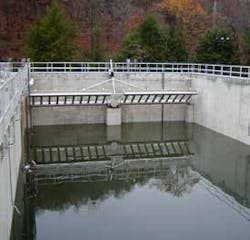The city of Portage is a former borough within Portage Township in Cambria County, Pennsylvania. Before a $10.2 million upgrade, the Portage Area Sewer Authority was operating in a facility built in 1972.
Project Background
The original plant utilized the contact stabilization activated sludge process (CSASP). The initial construction produced a footprint that included two aeration tanks with individual clarifiers, digesters and pumps. Also included were a bar screen, grinders and a pump station to accept collection system flows. Some of this original structure dated back to the 1940’s.
The plant effluent is received by the Little Conemaugh River that flows through scenic mountainous areas and watersheds that were environmentally degraded over the years by drainage from abandoned coal mine operations and other pollution.
Added peak capacity was a primary goal of the project to correct hydraulic limitations that previously required repeated bypasses during heavy rainfall events.
Solution
The original process was replaced by an integrated Xylem wastewater treatment system featuring the Sanitaire brand ICEASNDNP (Intermittent Cycle Extended Aeration System with the Nitrification/Denitrification/Phosphorous Process feature) for secondary treatment and nutrient removal.
The two basins for the ICEAS-NDNP system have Sanitaire Silver Series II fine-bubble diffused aeration with a total of 1,036 diffusers per basin served by shared 75-HP rotary blowers, a Flygt 140-GPM waste sludge pump and two submersible Flygt mixers.
A high level of automation and plant optimization is achieved from the Sanitaire supervisory control and data acquisition (SCADA) system.
The SCADA includes an automated solids inventory management system (SIMS), which automates basin mixed-liquor, suspended solids and wasting. A YSI D.O. (dissolved oxygen) monitoring and control system instills automated aeration for the ICEAS basins, optimizing energy usage.
The plant’s effluent quality has been impressive and consistent, especially during the peak flows that challenged the facility in the past.
Result
The ICEAS system’s smaller footprint requirement directly translated into lower construction cost and the flexibility to customize the continuous treatment cycle to respond to variable flows. Furthermore, the Sanitaire system’s modularity will facilitate incremental expansions at the Portage plant.
Since the ICEAS-NDNP process began operation in October 2010, the Portage plant has successfully met nutrient removal goals and has withstood and successfully processed I & I-induced surges that reached a 10-MGD peak.
Editor's Note: Scranton Gillette Communications and the SGC Water Group are not liable for the accuracy, efficacy and validity of the claims made in this piece. The views expressed in this content do not reflect the position of the editorial teams of Water & Wastes Digest, Water Quality Products and Storm Water Solutions.

